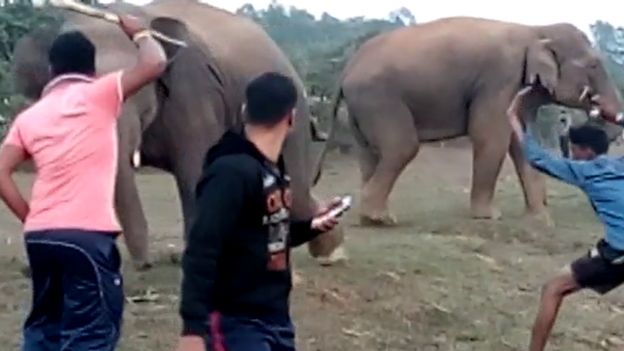The Indians dying because of wild elephant selfies

A worrying trend of taking selfies with wild elephants in the eastern Indian state of Orissa has led to attacks, with a few even dying as a consequence. Local forest officials fear that such incidents are on the rise, writes BBC Hindi’s Subrat Kumar Pati.
In December, Jaykrushna Nayak was walking home from the local village market when he spotted an elephant inside the village. A large crowd had gathered around, taking photos and teasing the animal.
Mr Nayak joined the crowd and also tried to take a selfie with the elephant. But in the process, the enraged animal wrapped its trunk around him and crushed him to death.
“A lot of people watched this happen, but no one could rescue him,” his son, Deepak Nayak, told the BBC. While others managed to escape, his father did not, he added.
A similar attack was reported in the state in September. Ashok Bharati, a security guard, was killed by an elephant after he went too close to the animal in an effort to take a selfie with it.
In the incident, captured on video by some onlookers, Mr Bharati is seen edging closer and closer to the animal, when suddenly the elephant charges at him.
Mr Bharti tried to escape, but was overtaken and trampled. He was rushed to a hospital but died on the way. The video of him trying to escape went viral.
Other selfie seekers have managed to escape with their lives, but have suffered serious injuries.
An engineering student, Abhisekh Nayak, was rushed to hospital after being gored by an elephant while attempting to take a selfie with it.

Six months later, Mr Nayak is still being treated for the severe injuries he suffered to his neck and stomach.
“There are many incidents of elephant attacks in the area, but only a few cases get reported,” Biswajit Mohanty, a wildlife expert, told the BBC.
The Orissa government has started to take this trend seriously. The chief wildlife warden of the state, Sandeep Tripathy, told the BBC that they are planning to “organise mock drills and special campaigns in sensitive districts to raise awareness” about the danger of getting too close to wild elephants.
State government data shows that 60 people have died due to elephant attacks in Orissa. How many may have died because of a selfie is unclear, but officials worry that the overall number could escalate because of the craze for pictures with the animals.
The trend has been exacerbated by the fact that a lack of food has forced elephants out of the forests and into villages and towns in the state, said Mr Mohanty. “Particularly in December and January, the elephants come out of the forest to eat the rice in the farms,” he said.
“As they come out in fairly large numbers, people get excited and start taking photos,” forest range officer BN Mishra, told the BBC. “But in doing so, the flash from their cameras irritate the animals, which is the main reason they attack,” he said.
Mr Mishra said that there have been efforts to try and combat the number of incidents by organizing meetings with the residents. “But it doesn’t matter, people are not taking it seriously,” Mr Mishra told the BBC.
Ratnakar Das, another forest officer, said that he routinely sees people in the area interacting with wild elephants when they wander into town. “People attract the elephants by feeding it sugar canes, and then they often try to take a selfie and end up provoking the animal in the process,” he said.

According to a study by researchers from Carnegie Mellon University and the Indraprastha Institute of Information in Delhi, India has recorded far more selfie-related deaths than any other country in the world in recent years.
But the problem of dangerous wildlife selfies isn’t just limited to India.
In 2015, officials at Yellowstone National Park in the United States issued a warning after five incidents of selfie-takers being gored by bison, while a man in Spain died trying to take a selfie with a bull.
In 2016, a man in a wildlife park in China was drowned by a walrus after taking selfies with the animal, and a zookeeper who jumped in to save him also died. A video compilation of the 25 most dangerous selfies on YouTube has been viewed over 40 million times.
Source: BBC






PMID 36046190 Free PMC article viagra priligy
Sfakianakis GN, Heiba S, Ganz W, et al buy generic cialis online safely Average Risk of a Second Breast Cancer